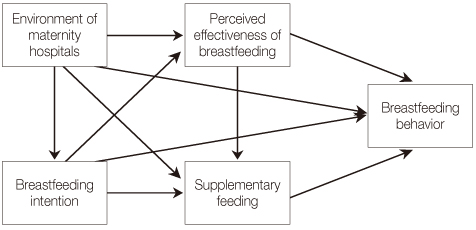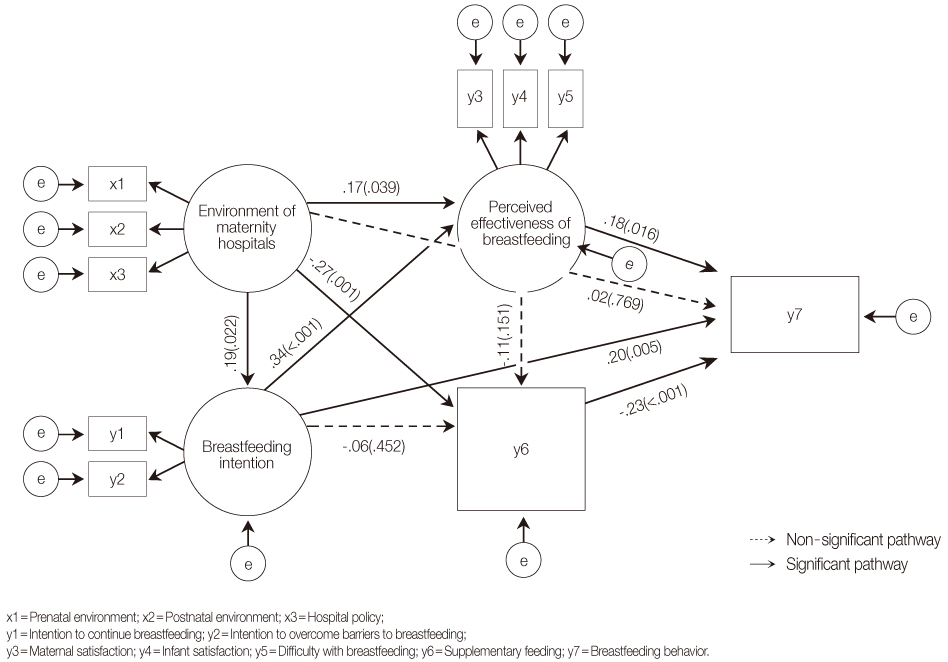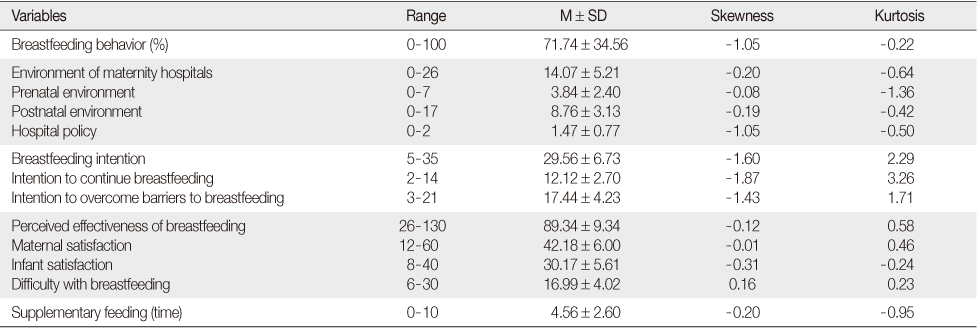Articles
- Page Path
- HOME > J Korean Acad Nurs > Volume 43(3); 2013 > Article
-
Original Article
- A Structural Model for Primiparas' Breastfeeding Behavior
- Hyun-Joo Yang, Ji-Min Seo
-
Journal of Korean Academy of Nursing 2013;43(3):399-408.
DOI: https://doi.org/10.4040/jkan.2013.43.3.399
Published online: June 28, 2013
1Department of Nursing, Kyungnam College of Information and Technology, Busan, Korea.
2College of Nursing, Pusan National University, Yangsan, Korea.
- Address reprint requests to: Seo, Ji-Min. College of Nursing, Pusan National University, Beomeo-ri, Mulgeum-eup, Yangsan-si, Gyeongsangnam-do 626-870, Korea. Tel: +82-51-510-8351, Fax: +82-51-510-8308, seojimin@pusan.ac.kr
• Received: January 8, 2013 • Accepted: April 16, 2013
© 2013 Korean Society of Nursing Science
Abstract
-
Purpose
- The study was done to construct and test a structural model to explain primipara breastfeeding behavior.
-
Methods
- The participants were 213 primiparas on postpartum wards. Data were analyzed using the PASW 18.0 and AMOS 19.0 programs.
-
Results
- Fitness statistics for the hypothetical model were appropriate (χ2 =38.50, p=.070, GFI=.96, RMSEA=.05, AGFI=.93, NFI=.95, TLI=.97, CFI=.98, PNFI=.57, χ2/df=1.43). Breastfeeding behaviors were directly influenced by intention to breastfeed, perceived effectiveness of breastfeeding, and the amount of supplementary feeding. The amount of supplementary feeding had the largest direct impact on breastfeeding behavior. The largest total effect on breastfeeding behavior was intention to breastfeed. The environment of the maternity hospital indirectly influenced breastfeeding behavior. These factors explained 18.9% of variance in the primipara breastfeeding behavior.
-
Conclusion
- The results of the study indicate that in order to promote primipara breastfeeding the amount of supplementary feeding immediately after the birth should be limited and an environment that encourages exclusive breastfeeding in the hospital should be provided. The results also suggest it is necessary to provide nursing interventions that increase the intention to breastfeed and the perceived effectiveness of breastfeeding.
This manuscript is a condensed form of the first author's doctoral dissertation from Pusan National University.
- 1. Bang MR. The influence of the traditional Korean childbearing culture on breast feeding. Seoul, Yonsei University. 1983;Unpublished doctoral dissertation.
- 2. Centers for Disease Control and Prevention. Breastfeeding report card United States, 2011. 2011;Retrieved August 24, 2011. from http://www.cdc.gov/breastfeeding/pdf/2011BreastfeedingReportCard.pdf
- 3. Cooke M, Sheehan A, Schmied V. A description of the relationship between breastfeeding experiences, breastfeeding satisfaction, and weaning in the first 3 months after birth. J Hum Lact. 2003;19(2):145–156. http://dx.doi.org/10.1177/0890334403252472ArticlePubMed
- 4. Dodgson JE, Henly SJ, Duckett L, Tarrant M. Theory of planned behavior-based models for breastfeeding duration among Hong Kong mothers. Nurs Res. 2003;52(3):148–158.ArticlePubMed
- 5. Ewha Womans University. Analysis of factors influencing the decision to breastfeed and breastfeeding rates (Policy issues, 2009-14). Seoul: Ministry of Health & Welfare; 2009.
- 6. Forster DA, McLachlan HL, Lumley J. Factors associated with breastfeeding at six months postpartum in a group of Australian women. Int Breastfeed J. 2006;1:18. http://dx.doi.org/10.1186/1746-4358-1-18ArticlePubMedPMCPDF
- 7. Gartner LM, Morton J, Lawrence RA, Naylor AJ, O'Hare D, Schanler RJ, et al. Breastfeeding and the use of human milk. Pediatrics. 2005;115(2):496–506. http://dx.doi.org/10.1542/peds.2004-2491ArticlePubMedPDF
- 8. Grummer-Strawn LM, Scanlon KS, Fein SB. Infant feeding and feeding transitions during the first year of life. Pediatrics. 2008;122:Suppl 2. S36–S42. http://dx.doi.org/10.1542/peds.2008-1315dArticlePubMedPDF
- 9. Hill PD, Aldag JC. Predictors of term infant feeding at week 12 postpartum. J Perinat Neonatal Nurs. 2007;21(3):250–255. http://dx.doi.org/10.1097/01.JPN.0000285816.44022.a3ArticlePubMed
- 10. Hill PD, Humenick SS. Development of the H & H lactation scale. Nurs Res. 1996;45(3):136–140.ArticlePubMed
- 11. Huang YY, Lee JT, Huang CM, Gau ML. Factors related to maternal perception of milk supply while in the hospital. J Nurs Res. 2009;17(3):179–188. http://dx.doi.org/10.1097/JNR.0b013e3181b25558ArticlePubMed
- 12. Huggins K, Ziedrich L. The nursing mother's guide to weaning. 2nd ed. Boston, MA: The Harvard Common Press; 2007.
- 13. Jang GJ, Kim SH, Jeong KS. Effect of postpartum breast-feeding support by nurse on the breast-feeding prevalence. J Korean Acad Nurs. 2008;38(1):172–179. http://dx.doi.org/10.4040/jkan.2008.38.1.172Article
- 14. Kim HS. Guide book for breastfeeding. Seoul: Hyunmoon; 2008.
- 15. Kim HS, Nam ES. Prediction of breastfeeding intentions and behavior: An application of the theory of planned behavior. J Nurs Acad Soc. 1997;27(4):796–806.ArticlePDF
- 16. Kim M, Kim SH, Lee JH. Types of breastfeeding and its predictors of mothers in twenty-four months after birth. Korean J Women Health Nurs. 2011;17(1):21–30. http://dx.doi.org/10.4069/kjwhn. 2011.17.1.21ArticlePubMed
- 17. Kim SH. Factors explaining mothers' breastfeeding satisfaction. Korean J Women Health Nurs. 2009a;15(4):270–279. http://dx.doi.org/10.4069/kjwhn.2009.15.4.270Article
- 18. Kim SH. Process of breast feeding mother’s adaptation. Korean J Women Health Nurs. 2009b;15(3):186–195. http://dx.doi.org/10.4069/kjwhn.2009.15.3.186Article
- 19. Kim SH. Factors affecting mother’s adaptation to breastfeeding. J Korean Acad Nurs. 2010;40(2):225–235. http://dx.doi.org/10.4040/jkan.2010.40.2.225ArticlePubMed
- 20. Kim SK, Kim YK, Cho OJ, Kim HR, Lim SO. The 2009 national survey on fertility, family health and welfare in Korea (Research report 2009-33). Seoul: Korea Institute for Health and Social Affairs; 2009.
- 21. Lee HS, Lim JH. Structural equation modeling with AMOS 18.0/19.0. Seoul: JypHyunJae Publishing Co; 2011.
- 22. Lee SJ, Seo JW, Park JO, Shin JH, Lee HR, Chung JT, et al. A survey on the factors related to the failure of breast-feeding the nutritional committee of the Korean pediatric association. J Korean Pediatr Soc. 1997;40(10):1336–1346.
- 23. Manganaro R, Marseglia L, Mamì C, Paolata A, Gargano R, Mondello M, et al. Effects of hospital policies and practices on initiation and duration of breastfeeding. Child Care Health Dev. 2009;35(1):106–111. http://dx.doi.org/10.1111/j.1365-2214.2008.00899.xArticlePubMed
- 24. Mulder PJ, Johnson TS. The beginning breastfeeding survey: Measuring mothers' perceptions of breastfeeding effectiveness during the postpartum hospitalization. Res Nurs Health. 2010;33(4):329–344. http://dx.doi.org/10.1002/nur.20384ArticlePubMedPDF
- 25. Nam ES. The effect of an educational program based on the theory of planned behavior on breastfeeding behavior. Seoul, Yensei University. 1994;Unpublished doctoral dissertation.
- 26. Overfield ML, Ryan CA, Spangler A, Tully MR. Clinical guidelines for the establishment of exclusive breastfeeding. 2nd ed. Raleigh, NC: International Lactation Consultant Association; 2005.
- 27. Park JH, Park YG, Jun HR, Park SW, Lee JY, Hwang SG, et al. Impact of delivery method and feeding supervision on breast-feeding. J Korean Soc Matern Child Health. 1999;3(1):7–21.
- 28. Semenic S, Loiselle C, Gottlieb L. Predictors of the duration of exclusive breastfeeding among first-time mothers. Res Nurs Health. 2008;31(5):428–441. http://dx.doi.org/10.1002/nur.20275ArticlePubMed
- 29. Song JE, Chang SB, Kim S. Childcare stress, postpartum depression, and postpartum fatigue between women who used and not used sanhujori facility. J Korean Soc Matern Child Health. 2008;12(1):33–46.Article
- 30. The Korean Committee for UNICEF. The Korea Committee for UNICEF annual report 2005. Seoul: Author; 2006.
- 31. U.S. Department of Health & Human Services. The health benefits of breastfeeding. 2010;Retrieved January 17, 2012. from http://www.healthcare.gov/news/factsheets/2010/12/breastfeeding.html
- 32. World Health Organization. Exclusive breastfeeding. 2002;Retrieved January 10, 2012. from http://www.who.int/nutrition/topics/exclusive_breastfeeding/en/
- 33. Yeo JH. Influencing factors in breast feeding duration. Korean J Women Health Nurs. 2005;11(2):142–147.ArticlePDF
REFERENCES
Figure & Data
REFERENCES
Citations
Citations to this article as recorded by 

- Predictors of maternal attachment among breastfeeding mothers in Jordan
Sawsan Abuhammad
Nursing Open.2021; 8(1): 123. CrossRef - Factors associated with Maternal Attachment of Breastfeeding Mothers
Sun-Hee Kim
Child Health Nursing Research.2019; 25(1): 65. CrossRef - Impact of Parenting Stress and Husband's Support on Breastfeeding Adaptation among Breastfeeding Mothers
Seung Hui Heo, Yoon Goo Noh
Korean Journal of Women Health Nursing.2017; 23(4): 233. CrossRef - Development of a Breastfeeding Effectiveness Scale (BES)
Hyun-Joo Yang, Min-Young Jeong, Ji-Min Seo
Korean Journal of Women Health Nursing.2016; 22(4): 264. CrossRef - Comparison of Lactation Problems, Knowledge, and Adaptation on Breastfeeding between Users and Non-Users of Lactation Clinic
Myoung Hee Yun, Hye Sook Shin
Journal of East-West Nursing Research.2014; 20(2): 112. CrossRef
A Structural Model for Primiparas' Breastfeeding Behavior


Figure 1
Conceptual framework.
Figure 2
Final model with parameter estimates.
Figure 1
Figure 2
A Structural Model for Primiparas' Breastfeeding Behavior
Descriptive Statistics of Variables (N=213)
Table 1
Descriptive Statistics of Variables (N=213)
 KSNS
KSNS
 E-SUBMISSION
E-SUBMISSION



 Cite
Cite

